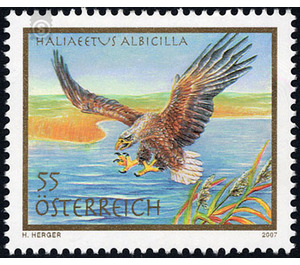sea eagle - Austria / II. Republic of Austria 2007 - 55 Euro Cent
Theme: Animals
| Country | Austria / II. Republic of Austria |
| Issue Date | 2007 |
| Face Value | 55.00 |
| Edition Issued | 960,000 |
| Printing Type | Photogravure |
| Stamp Type | Commemorative |
| Item Type | Stamp |
| Chronological Issue Number | 2019 |
| Chronological Chapter | OOS-OE2 |
| SID | 697618 |
| In 53 Wishlists | |
Joint Issue Austria - Serbia The extensive floodplain forests along the Danube as settlements of white-tailed eagles are the connecting element for the joint issue of Austria and Serbia. Larger white-tailed eagle populations can be found in the animal reserve in Vojvodina in Serbia. Even in the nature reserves in Austria along the Danube, March and Thaya, eagles begin to feel at home again. For the white-tailed eagle had died out over more than 50 years as a breeding bird in Austria. Hunting and disturbances at the breeding site and the robbery of eggs and young birds were the reasons for the extinction of the broodstock. Through the joint efforts of various conservation organizations, the conditions for the habitat of white-tailed eagles have been significantly improved in recent years. In the winter of 2000/2001 there was a successful breeding of the white-tailed eagle in Austria after a long time. The number of winter guests from Northern and Eastern Europe has also increased significantly in recent years. The habitat of white-tailed eagles is mainly on rocky shores, bays, large lakes and river landscapes. The distribution of European white-tailed eagle ranges from South Greenland over northern Europe to eastern Siberia. There are eight sea eagle species worldwide. Best known is probably the North American bald eagle. The white-tailed eagle reaches with its wings a span up to two and a half meters, it has a strong, markedly yellow beak and a wedge-shaped, almost white tail. With its truly imposing appearance, it corresponds entirely to the election of the heraldic animal of Austria. He is a versatile hunter, he prefers fish especially in the breeding season, but also attacks birds and takes in carrion fields in wintering areas. The bird of prey is also a master in the mouth robbery. He likes to stay close to cormorants, to whom he fights the catching, and searches for rubbish at their sleeping places. Eagles have a tendency to socializing, in crowded places and on sleeping trees they gather in droves. They often maintain lifelong partnership and sometimes use their clumps for years, which are among the largest nests in the animal kingdom. Impressive is their Balzflug in late autumn and winter time. White-tailed eagles breed on large old trees near nutrient-rich waters. During the breeding season, sea eagles are very sensitive to disturbances and easily abandon the nest. In Central Europe, oviposition takes place from mid-February to mid-March. One to three eggs are then incubated for five to six weeks. The young birds stay in the nest for a long time, up to 90 days, before they first fly around to explore their surroundings. White-tailed eagles can reach the age of 30 years and more.


